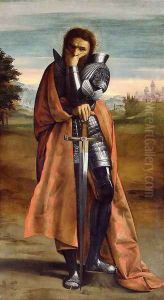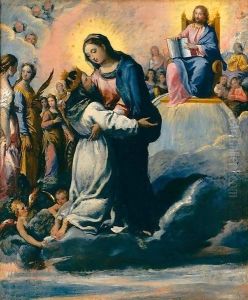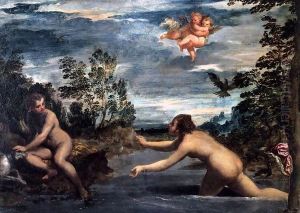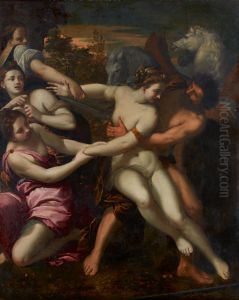Scarsellino Paintings
Scarsellino, born Ippolito Scarsella in 1551 in Ferrara, Italy, was a noteworthy painter of the late Renaissance or Mannerist period. His work is characterized by its vibrant color, dynamic compositions, and a delicate handling of light, which aligns him with the transition towards the Baroque style. The son of the painter Sigismondo Scarsella, Scarsellino was immersed in the arts from an early age, which greatly influenced his career path. Unlike many of his contemporaries who sought fame in Rome or Venice, Scarsellino's work was primarily concentrated in and around his native Ferrara, contributing significantly to the artistic landscape of the region.
Scarsellino received his initial training from his father and later worked under the guidance of Dosso Dossi, one of the foremost Ferrarese painters of the time. This early tutelage helped shape his stylistic direction, blending the Mannerist influence with a more naturalistic approach. He was also influenced by the Venetian school, evident in his use of color and light, which he may have absorbed through travel or the works of Venetian artists in Ferrara. Notably, his career flourished under the patronage of the Este family, the rulers of Ferrara, for whom he completed numerous commissions, including altarpieces, frescoes, and private devotional paintings.
Throughout his career, Scarsellino demonstrated a remarkable versatility, working on religious and mythological subjects with equal finesse. His frescoes in the Palazzo dei Diamanti and the Oratory of the Annunziata in Ferrara are considered masterpieces, showcasing his skill in creating complex narrative scenes filled with emotion and movement. In addition to his larger works, he was adept at small-scale compositions, which were highly sought after by collectors during his lifetime.
Scarsellino's contribution to the Italian Renaissance goes beyond his individual achievements. His works reflect the transition of Italian art from the High Renaissance ideals towards a more dynamic and expressive Baroque style. His influence was felt by his contemporaries and the next generation of artists in the Ferrara region and beyond. Despite the challenges posed by the shifting political and cultural landscapes of his time, including the decline of Ferrara as a major artistic center, Scarsellino maintained a successful career until his death in 1620. Today, his paintings can be found in major museums around the world, where they continue to be appreciated for their beauty and historical significance.



